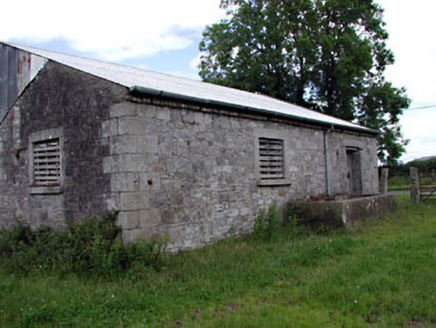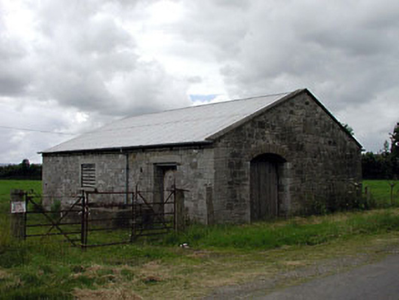Survey Data
Reg No
11903705
Rating
Regional
Categories of Special Interest
Architectural, Historical, Social, Technical
Original Use
Forge/smithy
In Use As
Outbuilding
Date
1820 - 1860
Coordinates
270995, 191052
Date Recorded
25/10/2002
Date Updated
--/--/--
Description
Detached two-bay single-storey rubble stone former forge, c.1840, with two-bay single-storey side elevations having segmental-headed integral carriageway to north. Renovated and partly remodelled, c.1980, to accommodate use as outbuilding. Gable-ended roof. Replacement corrugated-iron, c.1980. Iron ridges. Cut-stone coping to gables. Iron rainwater goods on yellow brick eaves course. Rubble stone walls. Cut-stone quoins to corners. Part corrugated-iron-clad, c.1980, to rear elevation to west. Square-headed openings. Stone sills. Cut-stone surrounds. Boarded-up. Cut-stone lintel to door opening. Timber panelled door. Segmental-headed integral carriageway to north. Red brick dressings. Boarded-up. Square-headed door openings inserted, c.1980, to rear elevation to west and to side elevation to south. Metal-sheeted doors. Set back from road perpendicular to road with side (north) elevation road fronted. Part overgrown grounds.
Appraisal
Ballyroe Forge (former) is a fine, small-scale building that is testament to the small-scale industry of County Kildare and which is therefore of considerable social and historic importance - the building is also testament to an age before the automobile when the local community relied on horse power for transport and farming activities. Although altered in the late twentieth century to accommodate a change in use, the main portion of the building retains much of its original character, features and materials. The construction of the building is of particular high quality and may be the result of it having been built on land owned by the Duke of Leinster. Important surviving early salient features include the cut-stone dressings to the openings. The forge is attractively located perpendicular to the road side in a flat landscape and is a pleasant and unassuming landmark in the locality.



